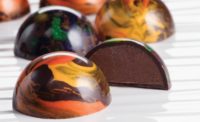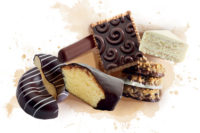What's in a name? That which we call a rose by any other name would smell as sweet. "Clearly, Shakespeare had no experience in the chocolate industry. Because while chocolate by any other name may taste as sweet, it has to contain nothing but or mostly cocoa butter (depending on specific markets) to be called chocolate. Any other fat and it becomes a "chocolatey" flavored coating. But have no fear, a compound coating still tastes just as sweet.
Innovations in the compound coatings field have transformed this ingredient, making it an integral staple of the chocolate industry. Today, compound coatings feature different fats, flavors and functions that are suitable for nearly any application.
As a result, compound coatings have become something that chocolate is not - flexible.
There are generally three accepted kinds of compound coatings: cocoa butter alternatives (CBAs), cocoa butter equivalents (CBEs) and cocoa butter substitutes (CBSs). What makes all of these drastically different from pure chocolate is the fat used. Anything used that isn't cocoa butter turns the product into a compound coating.
Ed Wilson, formerly with AAK and now a freelance consultant, has more than 30 years of experience in chocolate, fats and oils. He's seen trends within the compound coatings industry come and go, and has his finger on the pulse of what's currently happening.

"Everybody wants to go lower in saturates," says Wilson. "Most of the replacements for the trans products and non-hydrogenated products have over 90 percent in saturated fats. Manufacturers want to get that down."
The fats in compound coatings, no matter their levels, are what make them such a viable product for manufacturers.Compound coatings eliminate the need to temper chocolate - the process of heating, cooling and reheating the chocolate and maintaining a certain temperature during the manufacturing process. This saves on time and money, and, ultimately, results in a less expensive (though no less delicious) product for consumers as well.
Because of the less-volatile nature of compound coatings, manufacturers have more freedom when it comes to flavor, texture and the purpose of their products.
"I was looking at our groups of products recently and we have hundreds," says Dan Kazmierczak, R & D manager for specialty coatings, Blommer chocolates. "It's limitless what you can do with all the different fats out there and the different flavors."
That means a producer can make a purple-colored bar that tastes like a pumpkin, if they so desire. According to Kazmierczak, the creators of compound coatings will generally work with manufacturers to create the coating that's just right for them - which may take weeks or even months.
"Adding ingredients to a formulation can impact flavor, appearance, viscosity, texture and shelf life," says Joe Sofia, chocolate specialist and account manager, Cargill Cocoa & Chocolate."To overcome these challenges it's necessary to carefully consider the ingredients that are being added and test formulations thoroughly."
Compound coatings have also risen in popularity because of the added health benefits that may come from the end products. Bars, bonbons, or bites boasting added vitamins, protein, or other nutrients are becoming very popular among producers. And even more popular among customers.
"As the concern about health and wellbeing is rising and consumers are looking for food with health benefits, nutritive claims are important because consumers want to be able to indulge while doing something good for their health," says Courtney LeDrew, marketing manager for Cargill Cocoa and Chocolate.

A popular use, according to LeDrew, is in protein bars covered in a chocolate compound coating that aids in weight loss or management. The growth of the use of added nutrients in compound coatings offers many opportunities for new product development.
And just because the product is not pure chocolate, doesn't mean it isn't consumer-conscious. Wilson has seen compound coatings cleaning up their act while cleaning up product labels.
"Some companies can provide sustainable, certified palm kernel products," relays Wilson. "There's a lot of interest in cleaning up the label and actually making (the coating) a selling point instead of something to hide."
Because, above all, the customer is key. The desired end product - whether it be a pure dark chocolate bar or a naturally colored, vitaminfortified, protein-packed, fruitflavored bar with a "chocolatey" coating - is chosen by the today's shopper whose needs and wants vary more than ever.




